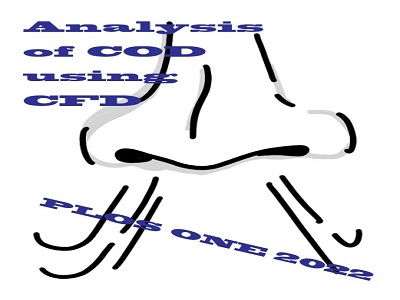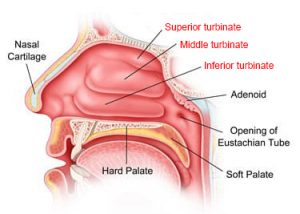【Fig4’s movie】Analysis of COD using CFD
2022/01/23

Analysis of conductive olfactory dysfunction using computational fluid dynamics
PMID: 35020767
DOI: 10.1371/journal.pone.0262579
Figure 4 shows the expansional details of this research, as an example of the idea of putting our analysis system into practical use.

(A)-(D) is an analysis of a patient with COD in the pneumatized superior turbinates.
(E)-(H) is an analysis of a patient with COD in the pneumatized middle turbinates (concha bullosa).
There are three types of rectifying plates inside the nose, the lower tier is called the inferior turbinate, the middle tier is called the middle turbinate, and the upper tier is called the superior turbinate.

The turbinate usually has a single plate-shaped bone and nasal mucosa on both sides, but the pneumatized turbinate has a hollow bone plate.
The superior turbinate or middle turbinate hollow structure is a relatively rare structural form, and it has been reported that disorders such as olfactory dysfunction and headache are likely to occur.
In our study, it was found that the pneumatized superior turbinate has a dead end structure and the air does not reach the depths of the olfactory cleft, and the air flow rate of the olfactory cleft is smaller amount than that of a healthy person.
In the pneumatized middle turbinate, although the olfactory cleft was a normal slit, a slow velocity vortex was generated in the flow path to the olfactory cleft (H), and findings suggesting inflammation due to air stagnation (E) were also found.
Photo (E) shows redness of the anterior mucosa of the pneumatized superior turbinates, which can be considered as localized chronic inflammation due to slow velocity air stagnation.
The video also shows a rapid flow in the narrow dorsal nose air way, which also suggests that odorants may be rapidly depleted before reaching the olfactory cleft.
For example, it is almost impossible to pass through the city road of Naples with an F1 machine at 300 km / h without hitting a wall.
[Fig. 4 video (Youtube)] (Caution! Not an F1 movie )
The merit of analyzing each patient individually is that the surgeon has a good understanding of the structure and flow in advance in surgical surgery, which is useful for actual surgery.
We think that stereotyped surgery is not good for surgery involving the sense of smell.
Therefore, we believe that our mission in the future is to spread the existence of this convenient system to medical professionals not only in Japan but all over the world.
Thank you for reading.
